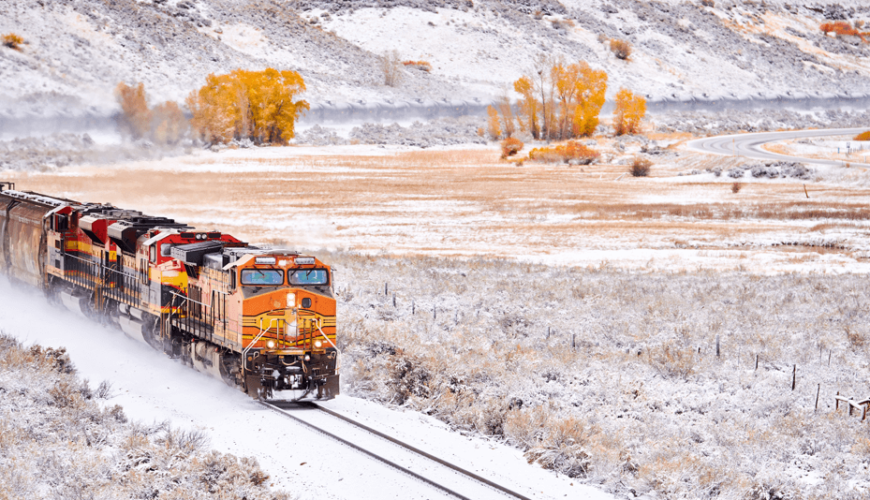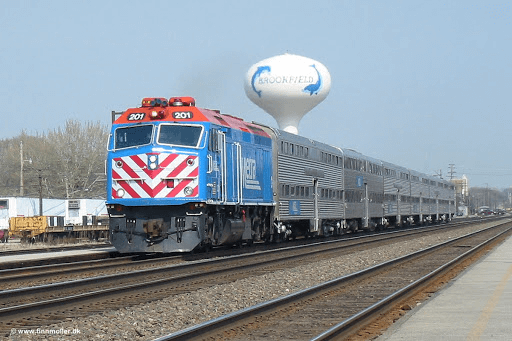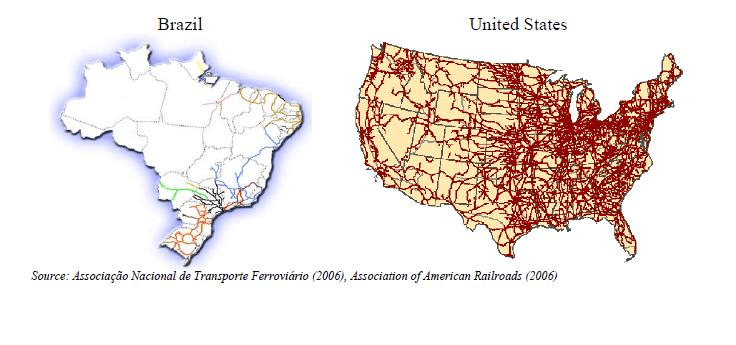
The USA and Brazil rail network: Understand the differences
Do you know the size of the Brazilian rail network and the the USA rail network? Well, here is the right place to understand a little more about comparing the rail systems of these two countries. But, first, it is necessary to explain some information about the greatness of the main aspects that make up the Brazilian territory and the North American, and in this way, you will understand why we chose these two nations to compare their rail networks.
Both countries are in the top 5 of the largest countries in the world in territorial size, according to data from the Brazilian Institute of Geography and Statistics (IBGE). Brazil is 8,514,876 km² long, ranking fifth on the list. The United States of America (USA) is 9,363,520km² long and is the fourth largest country in the world. The list is completed with: 1st Russia - 17,075,400km², 2nd Canada - 9,976,139km² and 3rd China - 9,596,961km².
In terms of population, according to figures from the IBGE, Brazil is the sixth country with the largest population in the world, with 209,469,320 inhabitants. The United States is the third most populous country in the world, with 326,766,748 inhabitants.
Looking only at the raw data of territorial and population extension of these two immense nations, you can imagine that the railroad sector of both countries has similar proportions, both in the extension of the kilometers of the roads, as well as in the care of the tracks and trains, the investments that are made and everything that involves this important cargo and people transport sector.
But in practice, this is not what happens. According to data from the United Nations (UN), the Human Development Index (HDI), which seeks to measure the development of countries worldwide, points to a sharp disparity between countries. While the United States occupies the fifteenth position in the ranking, held in 2019, Brazil occupies the indigestible 79th position.
The development of a country encompasses several issues, such as the economy, society, infrastructure, services offered to the population, such as transportation and among others. In this environment, the dimensions of the railroad lines fit into important aspects of services provided to the population, in addition to being important means of expansion and social and economic development. Trains are responsible for supplying products that are important for the countries' export and import economies, and are also useful for the daily transportation of people.
From now on, we will specifically address the intrinsic aspects of the Brazilian rail network and the USA rail network, to later draw a comparison of the rail sector between both countries.
Content Index
Brazilian railroad network

Unfortunately, the Brazilian railroad network has undergone a long period of abandonment and scrapping of lines, equipment and trains. From the mid-1950s until just before the early 2000s, investments in railroads were neglected by monetary investments in the growth of highways, which until today are the main form of cargo transportation in the country. According to notes by the National Transport Confederation (CNT), railroads are responsible for only 20.7% of cargo transported in the country, while 61.1% of cargo passes through highways. The rest of the percentage is made up of other modes of transport.
This number could be even more so if it were not for a change that occurred in the 90s that allowed the privatization of the railroads. Thus, the railroad lines started to be managed by different logistics companies. With the breath taking in the usefulness of the railroad, the government returned to invest in this sector, together with the private initiative that employed high values in the last years for expansion and improvement of the railroad networks.
The Brazilian rail network is growing, with projections of high investments for the coming years in the development of new lines and in the improvement of existing ones. Currently, the Brazilian railroad network is composed of 13 lines operating in cargo transportation and is 29,165 km long, according to notes by the National Land Transport Agency (ANTT). In day-to-day transport of people, there are 1,411 km of railroad network, totaling 30,576 km with the sum of the two molds.
As mentioned, there is a projection to expand the lines and improve the infrastructure of the existing railroads. In addition, some stretches are already under construction and others have been completed. You can check out more about the new line projects by clicking here.
The USA rail network

The USA rail network, in terms of mileage and cargo transported, is the largest in the world. According to data from the North American Intelligence Service, reported in 2014, the country was 293,564 km long and already boasted the first place in the ranking, with more than twice the mileage in relation to the second placed, China.
This number can be explained in a few ways. First, the North American country is a world economic leader in relation to GDP, as reported by the International Monetary Fund (IMF). The country has an economy valued at $ 25 trillion, just under double that of China, which is the second largest economy at $ 13 trillion. The economic factor alone already gives us a basis that it is natural for the country to be the largest investor in the USA rail network, especially if we take into account the country's territorial and population extension.
However, this expansive growth in monetary injection and the expansion of the USA rail network can be explained by a change in the organizational patterns of railroad management. According to information from Raymond Atkins, a former adviser to the Surface Transportation Board (STB), which is a federal council that deals with matters relating to the country's transportation, the United States was experiencing critical financial problems due to poor rail management, and change in management. Private companies now have more freedom in controlling roads, in stipulating freight and in investments. Thus, the US rail network started to grow exponentially.
The USA and Brazilian railroad network

Comparing the USA rail network and the Brazilian rail network is quite simple. In numbers, the disparity in the length of the lines in the two countries is enormous. The United States has more than 260 thousand km of lines more than Brazil. Even with the territorial and population extension of both nations being similar, the United States invests a much higher amount than that invested in Brazilian territory.
Brazil is made up of 26 states plus the Federal District, while the North American country is made up of 50 states plus its federal district. Although the Brazilian territory is divided into fewer states, the national rail network reaches far fewer locations than in comparison to the USA rail network. You will be able to see on the map, below, the difference in the reach of the railroad networks in both countries.


Finally, the last comparison we can make regarding countries' modes of transport is that, for every 100 kg of cargo handled in Brazil, only 15 kg pass through the railroad lines, whereas in the United States, 43% of cargo is handled on the tracks of the USA rail network.
Conclusion
Despite the new investments made in the Brazilian railroad lines, we could see that, in comparison with the United States, Brazil is still far below, mainly in the mileage of the railroads. Brazil still needs improvement and the creation of new routes to supply more and more Brazilian states and ports, points that are being researched and planned, both by the Federal Government and by the private initiative.
Searchs:
https://brasilescola.uol.com.br/geografia/estados-unidos2.htm
http://portal.antt.gov.br/index.php/content/view/4751/Ferroviaria.html
https://cnae.ibge.gov.br/images/7a12/mapas/mundo/continentes.pdf
https://www.abralog.com.br/noticias/malha-ferroviaria-brasileira-deve-dobrar-em-6-anos/
https://brasilescola.uol.com.br/geografia/maiores-paises-planeta.htm
https://www.cia.gov/library/publications/the-world-factbook/rankorder/2121rank.html
Comments are closed.













1 comments
Muito bom acessar essas informações, gosto muito de logística achei muito interessante as comparações entre Brasil EUA em relação a malha ferroviária, serve p termos uma noção de quanto os nossos governos dão pouca importância p esse modal.